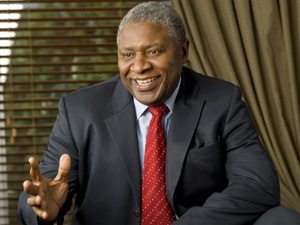
[miningmx.com] – EVEN the the soberest of mining executives were swept along by the commodity bull run of 2002 to 2012. This includes the measured Sipho Nkosi, CEO of Exxaro Resources, whose bass tones were heard targeting a market capitalisation of $20bn by 2020.
That was in 2012 when Exxaro was trading at about $10bn. Today, the market value is closer to $4.7bn with the share price trading at levels not seen since 2011, a performance that one senses has led to a degree of soul-searching at the company.
Executives at Exxaro Resources are discreet about the effect of the commodity climb-down on the company’s prospects, but one possible avenue of insight is an interest in bulking up the balance sheet.
Wim de Klerk, Exxaro Resources CFO, says the company is looking at raising alternate finance. This could be achieved by selling its 44% stake in Tronox, a business that deals in the highly specialised and price volatile world of titanium oxide – stuff that goes into paint pigment and tiles.
Exxaro has the option to take its stake in Tronox to 50%, but the fact it is considering the reverse suggests the company is also taking the opportunity of reviewing its portfolio. Similarly, it is considering increasing its exposure to export coal while shuttering less profitable domestic coal mines.
The group is essentially a very sound business but much of its near-term fortunes are tied to the political will and capability of government departments. Take, for instance, its R10bn Grootegeluk Medupi Expansion Project (GMEP) which is almost 97% complete but is yet to deliver a serious haul of coal.
That’s owing to the contractor and labour related delays at Eskom’s 4,800MW Medupi project which is more than two years late and, therefore, hasn’t been able to accept much coal from GMEP.
The outcome is that Eskom will have paid Exxaro an astonishing R3.6bn in penalties in lieu of revenue from coal. Some R350m has already been paid by Eskom in Exxaro’s 2012 financial year, a further R1.6bn in 2013; and in the group’s current financial year, which ends in December, a further R1.5bn will be paid, says De Klerk.
There will be another shortfall of coal deliveries in the 2015 financial year, he says. “We know that won’t be delivered,’ he said of some 6 million tonnes (mt) of coal that should be sold to Eskom in that year.
The likelihood is that Eskom will recompense Exxaro in terms of a take-or-pay penalty; in other words, if it is able to accept 5mt, the balance will be paid in a market-related fee, he said.
Exxaro is also waiting on the government of the Republic of Congo to approve outstanding conditions on a mining convention for a proposed iron ore mine known as Mayoko. Unlike South Africa, where permits are applied for separately, the RoC’s convention is a kind of one-stop shop of government blessings.
Despite promises last year that it was full speed ahead for Mayoko, the convention has been slow in the signing. Head of new business, Ernst Venter, spent three months in RoC extracting a signing of the deal but the conditions precedent are such that Exxaro isn’t putting any more cash into the venture, for now.
“All pieces of documents will be finaised by the end of March,’ said Nkosi. “From now onwards we are going to be able to work on numbers. Please wait and be patient. We are trying to ensure that we don’t waste your money by deploying capial where it is not necessary.’
Nkosi insists the company is not in hunkering down mode despite the pressure on coal prices. “We chose not to survive; we want to win under these conditions. We have to look after your money therefore we’ve got to win. We are not going to be on the survival mode,’ he said.
TRANSNET
Exxaro is getting some joy from another government-owned company with which it deals, Transnet Freight Rail, the freight division of Transnet.
According to Mxolisi Ngojo, head of Exxaro’s coal business, volumes on the coal line from the Waterberg is set to increase to 6.5 million tonnes a year (mtpa) from 4mpta this year.
“We are beginning to see culmination of process of engagement with Transnet and TFR,’ said Ngojo. “They [Transnet] are coming up with strategy to unlock north-west corridor. We have been working very hard with TFR and other critical stakeholders in saying what sort of structure we can put in place,’ he says.
“Physically, on the ground over next three to four years, the intention is to get to 28mpta on that line. The next loop [expansion of the rail line] will take capacity to 10mtpa and allow 200 wagon trains to be brought up,’ he says.
Providing better infrastructure to the Waterberg is critical is diversifying Eskom’s access to coal resources especially as it nears 2018 when many of the long-standing contracts expire and new ones have to be signed.
Exxaro is also bullish about its Thabametsi mine, production from which is a modest 3.8mtpa but which is expected to build over time. Venter says he’s excited about the protential.
“Thabametsi could develop into a similar complex as the Waterberg producing eight different products [of coal],’ he says. The mine has an estimated five billion tonnes of coa resources. “It’s massive,’ says Venter. “We will have to see how we can ratchet up from that.’








